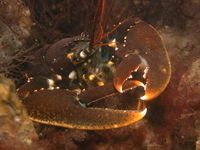Difference between revisions of "Pollution and scavengers"
(ref) |
|||
| Line 2: | Line 2: | ||
''Homarus gammarus'' © Vincent Zintzen | ''Homarus gammarus'' © Vincent Zintzen | ||
</div>]] | </div>]] | ||
| + | Decomposers typically live on the sea floor and include species like crabs, opossum shrimps, whelks and starfish.<ref> Moore P.G., Howarth J., 1996 Foraging by marine scavengers: Effects of relatedness, bait damage and hunger. Journal of Sea Research, Volume 36, Issues 3-4, P. 267-273 </ref> They feed primary on decaying organic matter, which can often contain high concentrations of [[pollutant|pollutants]]. <ref>Voorspoels, S.; Covaci, A.; Maervoet, J.; De Meester, I.; Schepens, P. (2004). Levels and profiles of PCBs and OCPs in marine benthic species from the Belgian North Sea and the Western Scheldt Estuary. Mar. Pollut. Bull. 49(5-6): 393-404</ref> | ||
| + | This causes decomposers to have a higher pollutant contents than other [[pollution and zoobenthos|zoobenthos]]. | ||
| − | + | Crabs, especially their larvae, appear to be vulnerable to pesticides <ref>Levinton, J.S. (2001). Marine biology: function, biodiversity, ecology. 2nd Edition. Oxford University Press: New York, NY (USA). ISBN 0-19-514172-5. xi, 515, col. pl. pp.</ref> This vulnerability caused the crab fishery of Chesapeake Bay in the 1960s collapse due to a pesticide called keptone. | |
| − | |||
| − | |||
| − | Crabs, especially larvae, appear to be vulnerable to pesticides <ref>Levinton, J.S. (2001). Marine biology: function, biodiversity, ecology. 2nd Edition. Oxford University Press: New York, NY (USA). ISBN 0-19-514172-5. xi, 515, col. pl. pp.</ref> This vulnerability caused the crab fishery of Chesapeake Bay in the 1960s collapse due to a pesticide called keptone. | ||
Below you can find some links to Belgian case studies on ecotoxicology in marine scavengers. | Below you can find some links to Belgian case studies on ecotoxicology in marine scavengers. | ||
Revision as of 09:32, 23 July 2009
Decomposers typically live on the sea floor and include species like crabs, opossum shrimps, whelks and starfish.[1] They feed primary on decaying organic matter, which can often contain high concentrations of pollutants. [2] This causes decomposers to have a higher pollutant contents than other zoobenthos.
Crabs, especially their larvae, appear to be vulnerable to pesticides [3] This vulnerability caused the crab fishery of Chesapeake Bay in the 1960s collapse due to a pesticide called keptone.
Below you can find some links to Belgian case studies on ecotoxicology in marine scavengers.
Case studies
Case study 1: Flame retardants organotin compounds and surfactants in opossum shrimps of the Scheldt estuary.[4]
Case study 2: Effects of endocrine disrupting compounds on embryonic development of opossum shrimps.G[5]
References
- ↑ Moore P.G., Howarth J., 1996 Foraging by marine scavengers: Effects of relatedness, bait damage and hunger. Journal of Sea Research, Volume 36, Issues 3-4, P. 267-273
- ↑ Voorspoels, S.; Covaci, A.; Maervoet, J.; De Meester, I.; Schepens, P. (2004). Levels and profiles of PCBs and OCPs in marine benthic species from the Belgian North Sea and the Western Scheldt Estuary. Mar. Pollut. Bull. 49(5-6): 393-404
- ↑ Levinton, J.S. (2001). Marine biology: function, biodiversity, ecology. 2nd Edition. Oxford University Press: New York, NY (USA). ISBN 0-19-514172-5. xi, 515, col. pl. pp.
- ↑ Verslycke, T.; Vethaak, A.D.; Arijs, K.; Janssen, C.R. (2004). Flame retardants, surfactants and organotins in sediment and mysid shrimp of the Scheldt estuary (The Netherlands). Environ. Poll. 136(1): 19-31
- ↑ hekiere, A.; Fockedey, N.; Verslycke, T.; Vincx, M.; Janssen, C.R. (2007). Marsupial development in the mysid Neomysis integer (Crustacea: Mysidacea) to evaluate the effects of endocrine-disrupting chemicals. Ecotoxicol. Environ. Saf. 66(1): 9-15
